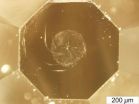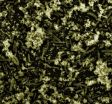(Press-News.org) Researchers from Moscow Institute of Physics and Technology, Technological Institute for Superhard and Novel Carbon Materials in Troitsk, MISiS, and MSU have developed anew method for the synthesis of an ultrahard material that exceeds diamond in hardness. An article recently published in the journal Carbon describes in detail a method that allows for the synthesis of ultrahard fullerite, a polymer composed of fullerenes, or spherical molecules made of carbon atoms.
In their work, the scientists note that diamond hasn't been the hardest material for some time now. Natural diamonds have a hardness of nearly 150 GPa, but ultrahard fullerite has surpassed diamond to become first on the list of hardest materials with values that range from 150 to 300 GPa.
All materials that are harder than diamond are called ultra hard materials. Materials softer than diamond but harder than boron nitride are termedsuperhard. Boron nitride, with its cubic lattice, is almost three times harder than the well-known corundum.
Fullerites are materials that consist of fullerenes. In their turn, fullerenes are carbon molecules in the form of spheres consisting of 60 atoms. Fullerene was first synthesized more than 20 years ago, and a Nobel Prize was awarded for that work. The carbon spheres within fullerite can be arranged in different ways, and the material's hardness largely depends on just how interconnected they are. In the ultrahard fullerite discovered by the workers at the Technological Institutefor Superhard and Novel Carbon Materials (FSBITISNCM), C 60 molecules are interconnected by covalent bonds in all directions, a material scientists call a three-dimensional polymer.
However, the methods providing production of this promising material on an industrial scale are not available yet. Practically, the superhard carbon form is of primary interest for specialists in the field of metals and other materials processing: the harder a tool is, the longer it works, and the more qualitatively the details can be processed.
What makes synthesizing fullerite in large quantities so difficult is the high pressure required for the reaction to begin. Formation of the three-dimensional polymer begins at a pressure of 13 GPa, or 130,000 atm. But modern equipment cannot provide such pressure on a large scale.
The scientists in the current study have shown that adding carbon disulfide (CS 2 ) to the initial mixture of reagents can accelerate fullerite synthesis. This substance is synthesized on an industrial scale, is actively used in various enterprises, and the technologies for working with it are well-developed. According to experiments, carbon disulfide is an end product, but here it acts as an accelerator. Using CS 2 , the formation of the valuable superhard material becomes possible even if the pressure is lower and amounts to 8GPa. In addition, while previous efforts to synthesize fullerite at a pressure of 13 GPa required heating up to 1100K (more than 820 degrees Celsius),in the present case it occurs at room temperature.
"The discovery described in this article (the catalytic synthesis of ultrahard fullerite) will create a new research area in materials science because it substantially reduces the pressure required for synthesis and allows for manufacturing the material and its derivatives on an industrial scale", explained Mikhail Popov, the leading author of the research and the head of the laboratory of functional nanomaterials at FSBI TISNCM.
INFORMATION: END
Scientists come closer to the industrial synthesis of a material harder than diamond
Scientists from MITP and RAS came closer to the industrial synthesis of a material harder than diamond
2014-09-15
ELSE PRESS RELEASES FROM THIS DATE:
Nurses need education on advance health care directives, reports Journal of Christian Nursing
2014-09-15
September 15, 2014 – An educational program for nurses can help address knowledge gaps related to advance health care directives (AHCDs)—thus helping to ensure that patients' wishes for care at the end of life are known and respected, reports a paper in the October/December Journal of Christian Nursing, official journal of the Nurses Christian Fellowship. The journal is published by Lippincott Williams & Wilkins, a part of Wolters Kluwer Health.
Maureen Kroning, EdD, RN, of Nyack (N.Y.) College and Good Samaritan Hospital presents her hospital's experience with developing ...
Skin cancer risks higher for soldiers serving abroad
2014-09-15
Soldiers deployed to tropical and sunny climates are coming home with increased risk factors for a threat far from the battlefield: skin cancer.
In a retrospective study of about 200 veterans seen at the post-deployment clinic of the Tennessee Valley Healthcare System of the U.S. Department of Veterans Affairs, researchers from Vanderbilt University Medical Center and the Tennessee Valley Healthcare System found that 62 percent of military personnel reported getting sunburned while deployed abroad, including cases of skin blistering. In addition, 29 percent noted a change ...
The science behind swimming
2014-09-15
At nearly 100 feet long and weighing as much as 170 tons, the blue whale is the largest creature on the planet, and by far the heaviest living thing ever seen on Earth. So there's no way it could have anything in common with the tiniest fish larvae, which measure millimeters in length and tip the scales at a fraction of a gram, right?
Not so fast, says L. Mahadevan, the Lola England de Valpine Professor of Applied Mathematics, of Organismic and Evolutionary Biology, and of Physics.
Using simple hydrodynamics, a team of researchers led by Mahadevan was able to show ...
Brain Development in Schizophrenia Strays from the Normal Path
2014-09-15
Philadelphia, PA, September 15, 2014 – Schizophrenia is generally considered to be a disorder of brain development and it shares many risk factors, both genetic and environmental, with other neurodevelopmental disorders such as autism and intellectual disability.
The normal path for brain development is determined by the combined effects of a complex network of genes and a wide range of environmental factors.
However, longitudinal brain imaging studies in both healthy and patient populations are required in order to map the disturbances in brain structures as they emerge, ...
Sleep disorders widely undiagnosed in individuals with multiple sclerosis
2014-09-15
(SACRAMENTO, Calif.) —In what may be the largest study of sleep problems among individuals with multiple sclerosis (MS), researchers at UC Davis have found that widely undiagnosed sleep disorders may be at the root of the most common and disabling symptom of the disease: fatigue.
Conducted in over 2,300 individuals in Northern California with multiple sclerosis, the large, population-based study found that, overall, more than 70 percent of participants screened positive for one or more sleep disorders.
The research highlights the importance of diagnosing the root causes ...
How evolutionary principles could help save our world
2014-09-15
The age of the Anthropocene--the scientific name given to our current geologic age--is dominated by human impacts on our environment. A warming climate. Increased resistance of pathogens and pests. A swelling population. Coping with these modern global challenges requires application of what one might call a more-ancient principle: evolution.
That's the recommendation of a diverse group of researchers, in a paper published today in the online version of the journal Science. A majority of the nine authors on the paper have received funding from the National Science Foundation ...
Boosting armor for nuclear-waste eating microbes
2014-09-15
EAST LANSING, Mich. – A microbe developed to clean up nuclear waste and patented by a Michigan State University researcher has just been improved.
In earlier research, Gemma Reguera, MSU microbiologist, identified that Geobacter bacteria's tiny conductive hair-like appendages, or pili, did the yeoman's share of remediation. By increasing the strength of the pili nanowires, she improved their ability to clean up uranium and other toxic wastes.
In new research, published in the current issue of Applied and Environmental Microbiology, Reguera has added an additional layer ...
Selway complex and Johnson Bar fires in Idaho
2014-09-15
Two fires are seen burning in this satellite image taken by the Aqua satellite on September 11, 2014. The Selway complex of fires had been previously reported located 30 miles west of Darby, MT. It appears a new fire may have started again in this complex. Currently the size of the complex is 1,659 fires. The fire is mostly contained and there will be no additional reporting on this fire unless activity increases. It is, for the most part, contained.
The Johnson Bar fire started with a lightning strike on August 03, 2014. To date, 8,867 acres have been affected. ...
New glaucoma culprit is found
2014-09-15
Glaucoma, a leading cause of irreversible blindness, is associated with elevated pressure in the eye. This elevated pressure essentially is due to a plumbing problem. Fluid builds up in the eye, increasing pressure and eventually damaging the optic nerve. For nearly 150 years, researchers have been trying to understand what causes the blockage that prevents the eye from draining properly.
In a unique study of human ocular cells, a multi-institution research team led by a biomedical engineer at Northwestern University has found a new culprit. Glaucoma appears to be a consequence ...
Getting hot and wet in Vermont
2014-09-15
Here's your northern Vermont forecast for the rest of this century: annual precipitation will increase by between a third and half an inch per decade, while average temperatures will rise some five degrees Fahrenheit by midcentury. By late in the century, average temperatures will have spiked more than eight degrees. In July, by 2100, the City of Burlington will have at least ten additional days above ninety degrees. The growing season picks up 43 more days. Looking at ski conditions, expect annual snowfall at six major ski resorts to decline about fifty percent by century's ...
LAST 30 PRESS RELEASES:
NASA’s Webb telescope finds bizarre atmosphere on a lemon-shaped exoplanet
The gut bacteria that put the brakes on weight gain in mice
Exploring how patients feel about AI transcription
Category ‘6’ tropical cyclone hot spots are growing
Video: Drivers struggle to multitask when using dashboard touch screens, study finds
SLU research shows surge in alcohol-related liver disease driving ‘deaths of despair’
Rising heat reshapes how microbes break down microplastics, new review finds
Roots reveal a hidden carbon pathway in maize plants
Membrane magic: FAMU-FSU researchers repurpose fuel cells membranes for new applications
UN Member States pledge to increase access to diagnosis and inhaled medicines for the 480 million people living with COPD
Combination therapy shows potential to treat pediatric brain cancer ATRT
Study links seabird nesting to shark turf wars in Hawai‘i
Legal sports betting linked to sharp increases in violent crime, study finds
Breakthrough AI from NYUAD speeds up discovery of life-supporting microbes
New Eva Mayr-Stihl Foundation funding initiative boosts research at University of Freiburg on adaptation of forests to global change
The perfect plastic? Plant-based, fully saltwater degradable, zero microplastics
Bias in data may be blocking AI’s potential to combat antibiotic resistance
Article-level metrics would provide more recognition to most researchers than journal-level metrics
Satiety’s little helper: Protein that supports appetite regulating protein identified
UF dives deep into predicting storm damage with computer models
A stormy ocean voyage yields insights on the global carbon cycle
Scientists identify first non-coding gene that controls cell size
Demonstration of altermagnetism in RuO₂ thin films -- A new magnetic material for the AI era
Penn researchers awarded $25M to conduct trial using smartphones to fight heart disease
PCORI awards funding for new patient-centered healthcare research
Exploring the origins of the universe: 145 low-noise amplifiers complete ALMA telescopes
Empress cicada wings help illuminate molecular structure
Using sound waves to detect helium
Time burden in patients with metastatic breast and ovarian cancer from clinic and home demands
Researchers discover bias in AI models that analyze pathology samples
[Press-News.org] Scientists come closer to the industrial synthesis of a material harder than diamondScientists from MITP and RAS came closer to the industrial synthesis of a material harder than diamond




